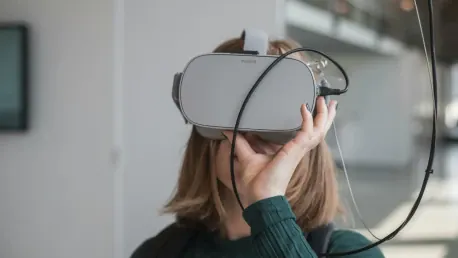The integration of Artificial Intelligence (AI) with Augmented Reality (AR) and Virtual Reality (VR) marks a revolutionary advancement, redefining interactions, learning, work, and play. These technologies have already started blending to create hyper-personalized, immersive experiences across various industries, significantly affecting businesses and individuals. By leveraging the unique capabilities of AI to adapt and respond in real-time, AR and VR are set to transform every aspect of our daily lives. From education to entertainment, and healthcare to retail, the applications of these advanced systems are growing exponentially, promising to elevate our experiences to unprecedented levels.
Enhanced User Experiences: Smarter and More Interactive
AI has brought intelligence to the initially aesthetic appeal of AR/VR, leading to environments that adapt and respond in real-time. AI-powered avatars are transforming education, customer service, and training by mimicking human-like interactions and adjusting teaching styles to suit individual learning paces. This will revolutionize how virtual tutors operate, tailoring lessons based on student performance, making learning more engaging. The personalized learning paths that AI can create will assist in addressing the diverse needs of students, facilitating a more efficient and inclusive educational environment.
In entertainment, AI can dynamically adapt storylines to fit individual preferences, pulling users deeper into the narrative. This intelligent system will constantly evolve, offering unique experiences that were previously unimaginable. Imagine playing a video game where the story adapts to your choices in a way that feels organic, or watching a movie that changes its plot based on your reactions. These enhancements will provide new dimensions to leisure activities, rendering them more personalized and engrossing. Consumer experiences will become increasingly reflective of individual tastes, ensuring that every user receives content that resonates with their unique interests.
The 5G Factor: Supercharging AR/VR
5G is far more than faster downloads; it is crucial for seamless AR/VR experiences. This technology will reduce latency to near-zero, enabling real-time collaboration in AR/VR, such as virtual surgeries and collaborative design projects. The nearly instantaneous communication that 5G facilitates is vital for scenarios where split-second decisions can mean the difference between success and failure. Industries that rely on precise and timely data transmission will see significant improvements in their operational capabilities.
With high-speed connectivity, live VR events from concerts to sports will become mainstream. This will revolutionize content consumption, allowing individuals to attend events from the comfort of their homes while still experiencing the atmosphere of being there live. Furthermore, 5G will support large-scale applications like remote training simulations in healthcare and manufacturing. Surgeons can practice complex procedures in a risk-free environment, while factory workers can undergo realistic training modules that prepare them for real-world tasks. The wide-reaching applications promise to significantly improve procedural efficiencies and outcomes across various fields.
Industry Applications: Revolutionizing Sectors
The convergence of AI with AR/VR is unlocking possibilities across healthcare, education, and retail. In healthcare, AI-infused VR simulations are enabling medical professionals to practice complex surgeries without risks, while diagnostic AR tools assist in real-time consultations. This reduces dependency on physical resources and minimizes patient risks during training exercises. Moreover, AR and VR can create detailed, immersive simulations that provide a more profound understanding of medical procedures, enhancing the educational aspect for both medical students and practitioners.
In education, AR and VR are turning classrooms into immersive spaces where students can explore historical events or scientific phenomena. These technologies allow students to engage with the subject matter in a hands-on manner, facilitating deeper understanding and retention of information. Retail benefits from AR glasses that let users “try on” clothes or visualize furniture in their homes, with AI providing tailored recommendations based on individual preferences. This personalized shopping experience helps consumers make more informed decisions while reducing the uncertainties associated with online shopping.
Hyper-Realism: Blurring the Lines Between Real and Virtual
Advancements in sensory technology are set to create experiences that feel astonishingly real. Future VR systems will incorporate touch, smell, and even taste, making virtual environments indistinguishable from reality. This hyper-realism will find applications in gaming, training, and therapeutic simulations. The level of immersion provided by these technologies can offer highly effective therapeutic treatments for conditions such as PTSD, phobias, and chronic pain, by placing patients in controlled, realistic environments where they can confront and manage their symptoms.
Social VR platforms will transform how we connect, fostering deeper engagement in personal and professional settings. These platforms will make distant interactions feel as real and impactful as face-to-face meetings. Virtual meeting spaces can provide the nuances of physical presence, making remote work more engaging and collaborative. From family gatherings in virtual living rooms to business negotiations in virtual boardrooms, the way people interact will fundamentally change, bridging distances and creating meaningful connections despite geographical barriers.
The Rise of Wearables: Comfort Meets Functionality
AR/VR hardware is evolving from bulky designs to sleeker, more practical ones. Smart glasses are expected to feature AI-powered object recognition, real-time translations, and contextual suggestions. These advancements mean that users will have access to real-time information and assistance, seamlessly integrated into their field of vision. This increased functionality, combined with improving aesthetics and comfort of devices, means that wearables will become a common accessory, driving wider adoption of AR and VR technologies.
Web-based AR will democratize their use, making these technologies accessible on any device with a browser. This evolution will make AR/VR accessible to a broader audience, enhancing everyday activities. Users will no longer be restricted by their hardware’s limitations, enabling more people to benefit from these technologies. For instance, navigation and wayfinding will be revolutionized, allowing individuals to receive directions and situational information directly through their glasses. These practical uses will make AR/VR indispensable tools in everyday life.
Enterprise VR: Reimagining Workspaces
AI and VR are reshaping how industries train employees, design products, and collaborate globally. AI-driven simulations in VR can tailor scenarios to individual learning needs in areas such as piloting aircraft and managing emergency surgeries. These advanced training modules reduce risk, enhance skills, and increase the efficiency of learning processes. Employees can experience realistic simulations that prepare them for complex tasks, improving their competency and confidence in performing their roles.
Virtual environments will allow designers and engineers to work on 3D models in real-time, streamlining innovation and reducing costs. These advanced workspaces will foster creativity and efficiency in ways previously unattainable. Collaborative design will become more intuitive and interactive, allowing team members from around the world to contribute to a shared project as if they were in the same room. The results will be faster development cycles, reduced costs, and improved product quality.
Generative AI: Accelerating Content Creation
The combination of Artificial Intelligence (AI) with Augmented Reality (AR) and Virtual Reality (VR) signifies a groundbreaking development, reshaping the way we interact, learn, work, and play. These technologies are already merging to create highly personalized, immersive experiences across multiple sectors, profoundly impacting both businesses and individuals. By harnessing AI’s unique ability to adapt and respond in real time, AR and VR are poised to revolutionize various aspects of our daily experiences. From education to entertainment, and healthcare to retail, the applications of these sophisticated systems are expanding rapidly, promising to enhance our experiences to unprecedented levels. Leading companies are investing heavily in these technologies, recognizing their transformative potential. Experts predict that the integration of AI, AR, and VR will bring about significant advancements in productivity, creativity, and overall quality of life, making this an exciting time for technological innovation.









